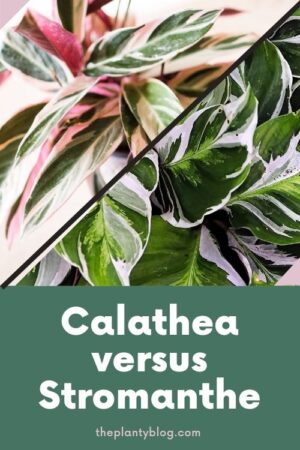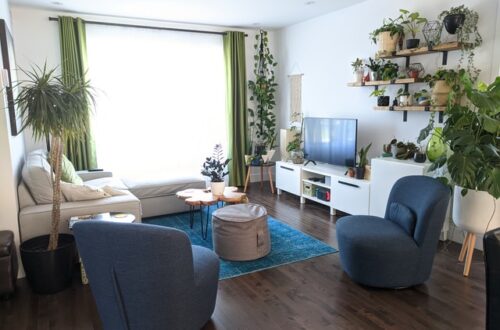
Calathea versus Stromanthe: Spot the Difference!
If you have ever seen a striking, green or patterned foliage plant in a garden centre with stunning red or purple backing to its leaves, which fold up at night, it probably had the label “Calathea” attached to its pot. But it might not actually be a Calathea – it could be Stromanthe! Understandably, the two would be confused for one another since they have both very similar appearances and care requirements. So how can you tell the difference?
While Calathea and Stromanthe are closely related as members of the Marantacae family, they are two different genera of houseplant. They can be distinguished by their physical characteristics, including their leaf shape and colour.
We’ll look at each plant genus, their dominant characteristics and differences in their care so you can decide which one works best for you or take better care of the plant you already have!
Let’s dive in!
Calathea versus Stromanthe: Taxonomy
Calathea
Calathea’s naming and taxonomy have taken on quite an interesting journey over the years, which has been controversial. Recently, several Calatheas were reclassified as a new species, Geoppertia.
This article will loop Calathea and Geoppertia varieties into the same category since many Geoppertia species are still commonly called Calathea. There are around 60-70 Calathea/Geoppertia species, with hybrids and other variations either being created or discovered as time goes on. They are a member of the Marantaceae family,
Calatheas grow predominantly in South America, along the forest floor. Several species are facing extinction due to habitat destruction. The locals use them to wrap food like fish or rice, and they are a natural food source for local herbivores.
Calatheas have a reputation for their ornate, decorative leaves, undoubtedly leading to their popularity as houseplants. They are used to receiving lower light levels on the forest floor, which makes it easy to adapt to household light conditions.

Stromanthe
Stromanthe is also a member of the Marantaceae family. While the Stromanthe genus also has around 20 known species, the most popular one is the Stromanthe Sanguinea, which is what we will be referencing here since these are the only species within the genus that is cultivated for houseplants, with some rare exceptions.
The name Stromanthe comes from the name stroma, Greek for meaning “bed,” and anthos, meaning flowers. This is often attributed to the stromanthe’s inflorescence, which looks like small white or coral flowers sitting on a “bed” of leaves.
The most common species, the Stromanthe Sanguinea, comes from red–red backing to their leaves.
This plant is Native Brazil, where they grow along the forest floor, receiving filtered sunlight and high humidity levels. In the wild, they can grow to an impressive 5 feet tall and 3 feet wide, although as houseplants, they can average to around 2-3 feet in height.
Calathea versus Stromanthe: Growth Similarities
It’s not a surprise that these two types of plants are confused with one another since both the Stromanthe and Calathea have very typical characteristics of the Marantaceae family. Often called “Prayer Plants,” both the Calathea and Stromanthe will move their leaves to absorb and reflect light, looking similar to hands folded in prayer.
Both species have rhizomes, meaning they both need to be propagated by division.
Calathea versus Stromanthe: Appearance
Since there are over 60 known species of Calathea, all with very unique appearances, we will compare some of the most commonly confused species of Calathea and Stromanthe so that you can tell the difference between the two.
Stromanthe Sanguinea (Green)
The Stromanthe Sanguinea is the most common species of Stromanthe. It has lance-shaped, dark green leaves with a dark burgundy backing. The tropical leaves have a subtle ripple pattern.

Stromanthe Sanguinea (Magic Star)
The Stromanthe Magic Star looks similar to the green version, except it has light cream-coloured speckles on the leaves. This plant grows slightly slower due to having less green on the leaves. The variegation on this plant is similar to the famous Monstera Thai Constellation, except you are much less likely to find a large, sectoral variation on the leaves.

Stromanthe Sanguinea (Triostar)
This plant is the most confused with Calatheas because the leaves are much more ornate. The variegation is pink and is much more sectoral; it appears in larger chunks on the leaves. The leaf shape is the same as the previous two variants. However, the backs of the leaves are a bit more opaque, and the colour is a brighter fuchsia, as opposed to a deeper burgundy. There also may be some cream-coloured sections in the plant.

Is Triostar a Calathea?
While the Triostar looks quite similar to many Calathea varieties, the Stromanthe Triostar belongs to a different plant genus. The Stromanthe Triostar is a close relative to the Calathea, but they are not the same.
Calathea Lancifolia
The Calathea Lancifolia has long, lance-shaped leaves, which are quite similar to the Stromanthe variety. However, the leaf shape is much more wavy than the Stromanthe. The leaf pattern has thick, darker green strips with the occasional spot. This unique pattern has earned this plant the nickname “Rattlesnake Calathea.” The undersides of the leaves are a dark aubergine.
Calathea Rufibarba
The Calathea Rufibarba has a very similar appearance to the Stromanthe green, so it is understandable that they may be mistaken for one another. The Rufibarba has long, lance-shaped leaves that have a similar ribbing pattern and an aubergine backing to the leaves. The biggest difference between the Rufibarba and the Stromanthe is that the leaves themselves are much wavier, almost ruffled in appearance. This is likely why it earned the nickname “Calathea Furry Feather.”
What Plant is Similar to Triostar Stromanthe?
The Stromanthe Triostar bears resemble a few other plants in the Marantaceae family, although if you inspect them closely, you can tell the difference between the two.
Calathea White Fusion
The Calathea White Fusion is the closest variety that resembles the Stromanthe Triostar. It has a similar sectoral variegation pattern mixed with solid green, so it might be easy to confuse the two of them at first glance. Looking deeper, there are some differences. The Calathea White Fusion has shorter leaves, for example. The leaves are triangular-shaped, and even though they can grow long when mature, they don’t have the same lance-like structure as a Stromanthe Triostar.
The next difference is the variegation colour. While Stromanthe Triostar can have a very light pink to creamy variegation, the Calathea White Fusion is a vibrant white. The backside of the leaf is also different. While the Triostar has a fuchsia-pink backing, the white fusion has a faded purple colour on the backs of its leaves.

Ctenanthe Oppenheimiana
The Ctenanthe Oppenheimiana also has a very similar appearance at first glance, but these plants are easier to tell apart from the White Fusion and the Triostar. The Ctenanthe Oppenheimiana has a similar leaf shape and growth pattern to the Triostar and has impressive variegation. It’s looking at the pattern itself that gives it away. The Ctenanthe Oppenheimiana has a silvery variegation that is more patterned and organized, while the Triostar produces leaves that are unique to one another.
Is Stromanthe a Ctenanthe?
Stromanthe and Ctenanthe are two different genera of plants, similar to the Calathea. While they all belong to the Marantaceae family, they are not the same plants. I’d like to think of them as cousins!
Calathea versus Stromanthe: Which is easier to care for?
I know that you want to know the answer to this! Unfortunately, it isn’t terribly simple. While the green Stromanthe Sanguinea is by far the easiest of the two genera, the Triostar can be more challenging than most Calathea varieties. Here’s why:
Stromanthe Sanguinea Green versus Calathea
In my experience, the green Stromanthe is much easier to care for than most of the Calathea varieties. Stromanthe Sangiuinea Green has none of the ornate variegation that Calatheas have. Their foliage tends to be slightly waxy, which I’ve found gives it reasonable protection from losing too much moisture too quickly. I have found it to be much more tolerable of normal household conditions and humidity levels. It can even be slightly more forgiving than most Calathea varieties of late watering.
Does that mean that the Stromanthe Sanguinea is an “easy plant”? Not necessarily, but I know that I have found it much more hardy than any Calathea I have or have had in my collection.
Strpomanthe Triostar versus Calathea
The triostar, unlike its all-green relative, is actually more difficult than most Calathea varieties. The Triostar is comprised of mostly variegated leaves. The leaves themselves are thinner, more sensitive to humidity and temperature, and more likely to curl and become upset if you let the soil dry out. I would consider the Stromanthe Triostar on par with some of the more delicate and therefore challenging Calatheas to care for, like the Roseopictas, the Orbifolia, or the White Star/Majestica.

Luckily, there are some small ways to better your odds:
- Go for a larger, healthy plant to start
- Use a humidifier for consistent, efficient humidity levels
- Give it medium light and filtered water at room temperature
- Use a moisture meter and water it thoroughly when the soil is nearly dry.
- Treat it for pests monthly
- Treat it regularly for fungal infections
Stromanthe Triostar versus Calathea White Fusion: Which is easier?
In nearly all cases, the Calathea Triostar is easier to care for than the Calathea White Fusion. However, you can find success with either plant with some extraneous measures to replicate those tropical conditions. The reason why the Triostar is ultimately easier than the White Fusion is that its Calathea rival is a pest magnet. Their very tender leaves are prone to developing crispy edges, and pests will go after them if they are distressed, particularly thrips and spider mites. Being diligent about your pest prevention measures is key to having a happy Calathea White Fusion.
Stromanthe Magicstar versus Calathea: Which is Easier?
The Magistar is the perfect middle ground between the green and the Triostar varieties. It is ideal if you are looking for a compromise, if you love the aesthetic of the Triostar and are willing to put up with less of the more sectoral variegation in exchange for a plant that is a little more laid back. It can develop crispy tips occasionally, but that surplus of greener foliage keeps it pretty hardy otherwise.
Things to Consider When Comparing “Easy” or “Hard” Plants
I was very early on in my plant journey when I started caring for Calatheas, and all of them did pretty well under my care. Just because you are a beginner does not mean that you are considered “hard to care for .”Some people have no trouble caring for more sensitive tropical plants. Just make sure you research your plant before bringing it home and do your best to replicate its natural environment.



